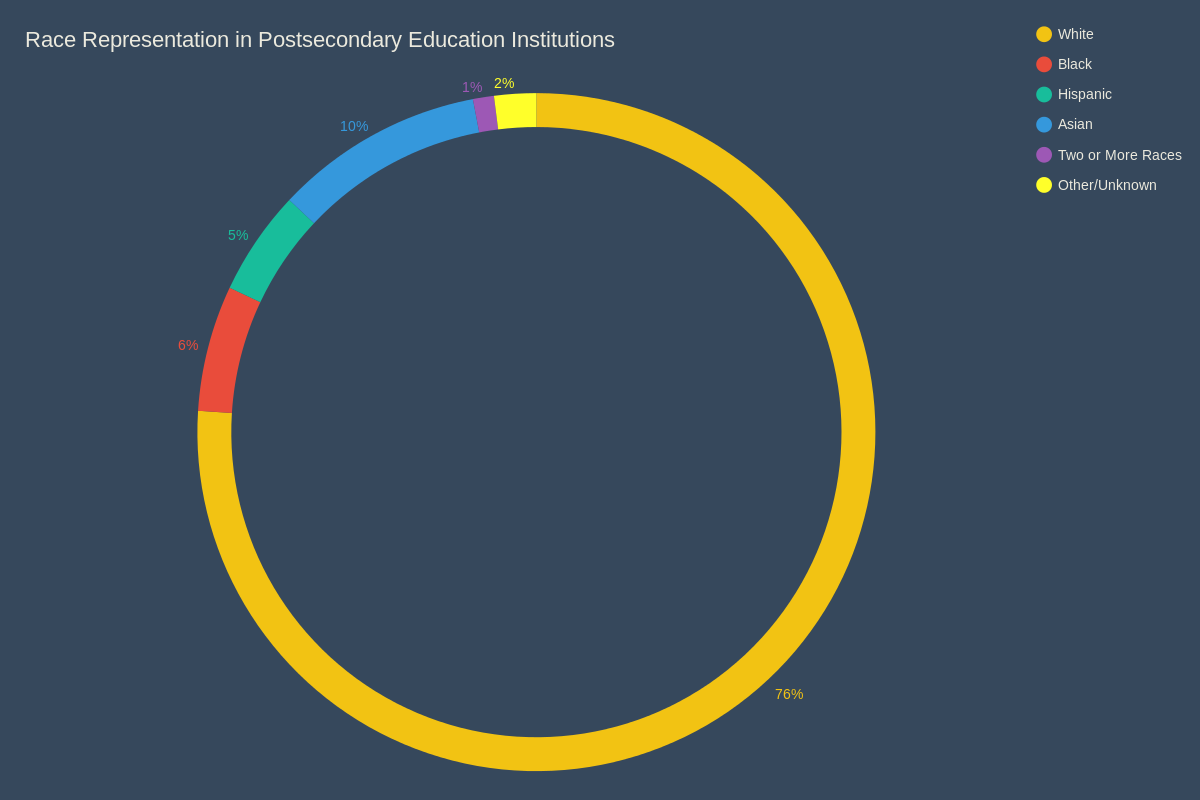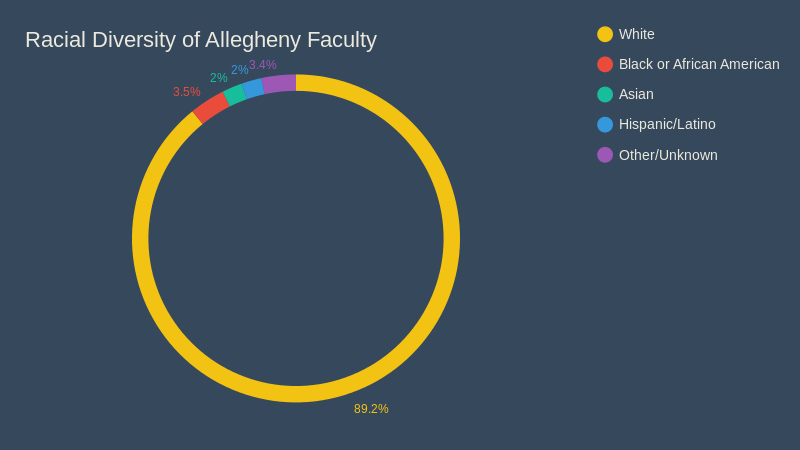The black experience at Allegheny is unlike any other. Coming to Meadville and seeing confederate flags on trucks and houses is a different kind of trigger for black students and faculty.
—Kristin Dukes, Dean for Institutional Diversity
Part 1 - Faculty Diversity
The racial diversity representation at Allegheny College is far less than the national averages of other institutions for black, Asian, and Hispanic faculty. Furthermore, the black experience at Allegheny College, for faculty and students alike, comes with its own unique challenges.
Kristin Dukes, the Dean for Institutional Diversity, met with me to help better understand where Allegheny College stands in terms of hiring more black faculty members. In our discussion, we explored exactly how diverse Allegheny’s faculty is, where we stand in relation to other schools, what the college is doing to hire more faculty of color, and why hiring more black faculty is a deceptively daunting task.
Evidenced by the headlining image, Allegheny’s faculty is primarily white. In fall of 2017, there were 169 full-time faculty members, of which 139 are neither faculty of color nor international faculty. To see just how Allegheny stacks up, consider the percentages of white faculty in comparison to faculty of other racial backgrounds.


Although behind the national average in terms of diversity, Allegheny has different standards for comparing itself to other institutions. Allegheny reports based on its standard comparison group (SCG), a group of schools deemed by the college to be similar to Allegheny in size and climate to guide institutional policy decisions. This standard comparison group is currently being reviewed, but is the same as what is currently listed on the Allegheny website. By all found accounts, Allegheny College is on par with the other schools in its SCG.
Part 2 - Effects of (the lack of) Faculty Representation
We need support. Who are we supposed to go to? To look up to?
—Brianna Watson, ‘19
Regardless of how Allegheny stacks up with other schools in its SCG, students of color feel a lack of support and a need for a more racially diverse faculty. Brianna Watson, class of 2019, said in an interview that there isn’t enough support for students of color. “Any student of color; black, Asian, Hispanic… who are they supposed to lean on for support?” Reconsider the headline image of this article: can you identify all of the black faculty or staff members?
Part 3 - Black Faculty at Allegheny College
This sentiment is also echoed by the faculty itself — in the 2009 Biennial Report of the Diversity and Gender Equity Committee, faculty were surveyed with a series of questions from the Higher Education Research Institute (HERI), wherein they were asked on a scale of 1 (strongly disagree) to 4 (strongly agree), how much they agree that “this institution should hire more faculty of color.” The response was overwhelming in favor of agree, with an overall faculty average of 3.2. Furthermore, Kristin Dukes, during our interview, told me that the College is actively engaged in efforts to hire more faculty of color.
Students want and need Allegheny College to hire more faculty of color. While the diversity in faculty is overall lacking, there is a distinct absence of black faculty. Of the six faces highlighted in the infographic above, five of them are faculty. Of the five, only four are full-time at Allegheny. Half of those four are tenured — leaving the remaining two black faculty in limbo with regard to their tenure status. The below graphic provides more information about these faculty and staff members.
Part 4 - The Challenge of Hiring Black Faculty
Not only is the lack of a black faculty presence apparent, but there is a particularly unique challenge when it comes to finding black faculty. While the college is actively seeking more faculty of color (and, specifically, black faculty), Kristin Dukes pointed out that the black experience in Meadville comes with triggers unique to black faculty. Noting an educational, socioeconomic, and racial divide, Dukes noted how difficult it is for black faculty to find the “creature comforts” that any person would need: social interactions, food, and sunshine. She described Meadville as an insular community that you need to break into in order to be comfortable. And even once that happens, there will still be encounters and times when living in Meadville as a black professor is particularly difficult.
I met someone who said I am a ‘clean and classy black,’ so I must not be from around here. Another time, after telling someone I worked at Allegheny, I was told that if I was cleaning staff, I ‘should work at Edinboro, it’s a better job.’
—Kristin Dukes
To come to Meadville and to come to Allegheny College are one in the same. It is often the common misconception that the city of Meadville and the campus of Allegheny College are in different realms, but the simple fact of the matter is that Meadville and the college are one community. If you drive onto campus from town via North Main Street, and continue driving on that road, you transfer from Meadville to Allegheny College and from Allegheny College to West Mead in a matter of moments. Combine this with the fact that local bars have counter tops decorated with confederate flags made of pennies and walls adorning the ‘stars and bars,’ an active local chapter of the Ku Klos Knights of the Ku Klux Klan, and a city population that is at most five percent black, and the immediate deterrents for black faculty to come to Allegheny become clear.
Furthermore, Allegheny is not going to hire black faculty for the sake of having more black faculty. Dukes stated it clearly: “I’d sooner hire ten white folks who have equity in mind over a single black candidate who isn’t equity-minded.” As standard hiring process, every applicant must include a diversity statement, intended to assess each candidate’s dedication to creating an equitable environment or putting in the work necessary to facilitate a diverse campus climate. Even once a person of color is hired as a new faculty member, though, other factors must be considered for the mental and emotional health of the newly hired.
Part 5 - Hiring Black Faculty is Hard; Retaining Black Faculty is Harder
As if finding a black faculty member who is willing to come to Meadville, PA and make an honest attempt at joining this community as an instructor wasn’t difficult enough, there’s still one major issue for the newly hired: retention. Allegheny College historically has struggled to retain faculty of color. In the 2009 Biennial Report of the Diversity and Gender Equity Committee, it is reported that zero percent of faculty of color hired between 1993 and 1998 were retained by 2009, and two out of three of the faculty of color hired in 1999-2000 were retained. That is a total loss of 75% of all faculty of color hired from 1993-2000 by the year 2009. This is the most recent, complete set of data available to me at this time for historic faculty of color retention data.
What makes the retention of black faculty so difficult? Well, aside from the aforementioned reasons (such as lacking a safe social environment), there are other factors such as a lack of support for black faculty and a high volume of demand for support from black faculty for black students. Since there are so few black professors in general, black professors often have to outsource receiving support in their instructing roles from external contacts at other universities. Black faculty must also rely heavily on the support of their white allies on the faculty as they make the transition into this new, relatively hostile environment.
Not only do the black professors need support, but they also act as magnets to a support system that is desperately sought after by students. Many people believe that if faculty of color is hired, they will immediately be ready to enter the role of supporting students, or that they will even be interested in doing the work necessary to create this support. It is a common narrative that the faculty of color leave Allegheny because the school is unwelcoming, but other factors such as lack of support and the harsh environment ultimately end up being what drives most of them away.
Part 6 - Conclusion
For any POC faculty moving in, if you’re willing to stand steadfast, this place can get better. It’s not wonderful now, but it can get better.
—Kristin Dukes
At the end of the day, regardless of perception, Allegheny College is making a distinct, concerted effort to hire more black faculty members. In years past, there has been a program which has run in iterations called the Diversity Scholar in Residence. It has been revived this year, and revived with a focus on hiring more faculty of color and providing the support they need to stay. The program includes additional layers of mentoring at the departmental, collegiate, and external levels, features decreased teaching loads for incumbent faculty of color (reduction from a 3-3 to a 2-2 [2-2 means 2 courses in fall and 2 courses in spring]) with the same opportunities as professors with higher loads, reviving faculty of color meet-and-greets, and more. But there are many factors that make this task difficult, even beyond what I have mentioned already (for example, competing with R1 research schools to hire the same candidates with less money to offer).
While there is a long way to go, it seems pretty clear that Kristin Dukes and Allegheny College are making an honest effort to increase the faculty diversity, especially with black professors, and is doing what it can to work within the goals of the college. As Dukes said in our interview, “We want to find the right people willing to dig in, take a couple of bruises, and support the overall goals of the college.”
